A note on Ascendancy foodways with a digression on Irish stew and a short detour to Boston.
1. A vanished world.
The Protestant Ascendancy of Ireland is unfashionable in these politically correct days. No one should argue that British rule was anything but largely inept and counterproductive to the interests of the Irish people, but a few feeble flames of admiration for Anglo-Irish culture justifiably flicker from time to time. The literature of Bowen, Edgeworth, Swift and Yeats remains beyond reproach; even Ireland itself belatedly comprehends the beauty of its Dublin buildings by Gandon and Pearce.
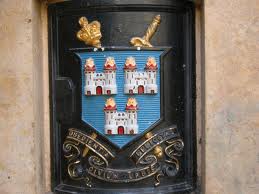
Oddly enough, food may be another field that scholars, or commentators at least, have begun to consider an Ascendancy contribution to the greater good. Not without trepidation, we have argued elsewhere at britishfoodinamerica that Ascendancy foodways form the foundation of contemporary Irish cuisine. While little academic research has been undertaken on the subject, that assertion may not turn out to be so controversial after all.
According to Colin Spencer, a writer hardly unsympathetic to Ireland, “[m]any of the dishes now prized stem from the Anglo-Irish kitchens of great estates whose old recipe books have come to light; all the game pies, for example, and fish dishes like scallops with cream and hot buttered lobster have their origin here.” (Spencer 179)
Martin Mac Con Iomaire also has noted “the influence of the Anglo-Irish ascendancy [sic] on dining habits” and has written that the “Anglo-Irish elite enjoyed sophisticated conspicuous consumption from early Georgian days, emulating eating patterns in London and Paris.” (“Irish Culinary Manuscripts” 82; “Searching” 92) In the essay itself, however, Mac Con Iomaire demonstrates no such influence and describes no food.
2. Subjects of scorn with a digression on Irish stew.
During 1977, Alexander Cockburn wrote that all Irish food is “justly maligned” but added that non-Irish authors of cookbooks bungled what might in surer hands have been decent dishes like Irish stew. (Cockburn) Things have improved, but even back in the seventies a few lonely advocates were speaking on behalf of Irish cuisine.
Three years earlier than Cockburn’s attack, Rosie Tinne, co-owner of the celebrated (but now defunct) Snaffles restaurant in Dublin had published Irish Countryhouse Cooking in an effort to redress the bad reputation of Irish food. The book is a compilation of recipes from the owners of surviving ‘Big Houses’ and from Tinne herself. Along with a number of other cookbooks, it received a vicious review in an entertaining and unfair essay by Cockburn called “Gastro-Porn” in The New York Review of Books.
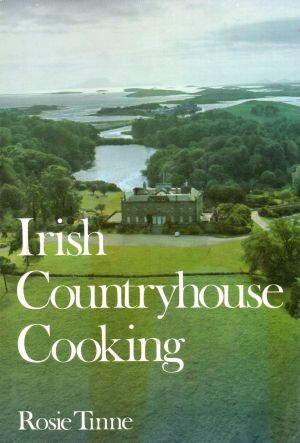
While some Countryhouse recipes are clunkers (like the ‘cold fish curry’ made from spaghetti and white sauce that Cockburn describes with wicked relish), Irish Countryhouse Cooking is in fact a lovely book. Good preparations outweigh bad and Tinne gets Dublin coddle right too.
Cockburn was out of his depth in attempting to describe Irish food. A deft passage from “Gastro-Porn” says that most cookbooks bowdlerize recipes for Irish stew with fripperies like bouquet garni and celery, and calls out Paul Bocuse in particular for including them while omitting pearl barley, “which,” he says,
“is the whole point and without which life--so far as Irish stew is concerned--lacks all meaning. There should only be meat, potatoes, onions, and barley.” (Cockburn)
All this is witty and would be fine except for the fact that all of it is wrong. Cockburn contends that Escoffier “gives virtually the same recipe” as Bocuse but the Editor’s unabridged Escoffier contains no such abomination. His recipe for Irish stew includes only lamb, potatoes and onions with, Escoffier cannot resist, “an herb bunch in the center.” (Escoffier 458)
That touch of green hardly renders the dish rogue, except in Ulster where the preparation sans bouquet goes by the name “white stew.” Down south, seasonings of bay, parsley, rosemary, sage and thyme, together or in various combination, are not uncommon, and even though the Editor limits her primary ingredients to the white trinity, many cooks add carrots or parsnips or even (but shudder) peas.
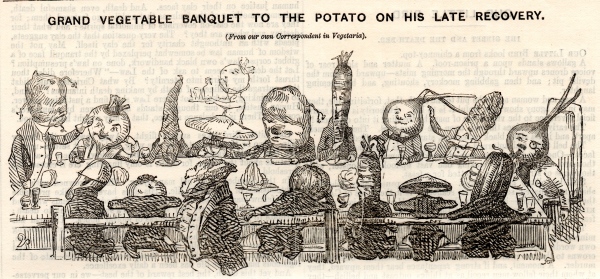
As Spencer explains, “Irish stew made with mutton, onions and potatoes could not be more basic; yet if made with care with all the fat skimmed off it is a fine dish.” (Spencer 179) It also is, as Theodora FitzGibbon notes, “very likely one of the oldest Irish recipes in existence.” (Irish Traditional Food 107) Her soothing stew includes only lamb, onions, parsley, potatoes and thyme: “Other vegetables and barley are sometimes added but they do not improve it.” (Irish Traditional Food 107, 108) The novelist and playwright Molly Keane, a fellow minimalist, keeps it simple too, adding the parsley but no thyme. (Keane 33)
A representative version of Old School Irish stew appears somewhat paradoxically in English Country House Cooking by Fortune Stanley. In its entirety:
“8 lamb cutlets pinch of dried rosemary
1 lb potatoes stock
2-3 onions
Trim the cutlets of fat and gristle. Put a thin layer of sliced potato into a lightly buttered casserole, then a layer of sliced onion, then half the cutlets, rosemary (or mixed herbs) and seasoning. Add more potato, the rest of the onion, the rest of the cutlets, again seasoned, and finally a thick layer of potatoes. Add enough stock to bring the top potato layer almost awash.” (Stanley 78-79)
A good recipe and well-written too. Use shoulder chops and substitute a couple of sprigs of fresh rosemary for the pinch of dried, or instead throw a bay leaf and scant teaspoon of dried thyme into the pot. Alternatively follow the lead of Mrs. FitzGibbon and plump for parsley with your thyme.
For those of a nontraditional bent, the Allens at Ballymaloe have a wonderful recipe for modernist Irish stew that incorporates a darkened roux, and the Editor has been known to bathe it in Guinness instead of stock or water.
From all this the reader may note that traditional Irish stew has nothing to do with barley, as Escoffier himself obviously understood. It is a fine ingredient; Mrs. FitzGibbon has a recipe for lamb stew with root vegetables and barley (no potato). Lamb with mushrooms and barley is an old London tradition (barley and hops for beer both are grown in great volume throughout the Home Counties) but it has no historical association with Irish stew itself, an old cottage recipe based more on subsistence (the lamb, the onion, the potato) than on a purchase like grain.

Ballyvovane Castle
Traditional Irish stew has had scant association with the Ascendancy either. As late as the interwar years one Big House forbade it from the dinner menu along with cheese and curry, although it (and they) could conceivably appear at ‘luncheon.’ (Somerville-Large 358)
3. An effort at rehabilitation.
Tinne explained in her “Forward” to Countryhouse Cooking, which appropriately enough includes no recipe for Irish stew, that
“Ireland has never boasted a reputation for fine food…. traditional cottage cooking… can be tasty [but] rarely takes advantage of the wealth of fresh ingredients available here in Ireland….
It seemed to me wrong that Ireland’s gastronomic reputation should rest on cottage cooking, and it was for this reason that I set out to collect recipes from the houses where higher standards have prevailed for many generations, and where superb meals can still be enjoyed today.” (Tinne; unpaginated introduction)
Tinne addresses, in other words, the surviving foodways of a lost civilization, the Protestant Ascendancy.
To be fair, she includes a few unrelated recipes. Myrtle Allen’s good version of dressed crab with chutney is one of them, but then Allen, who considers Irish food distinctive, also has, according to Mac Con Iomaire, noted its similarity to the cooking of England, Scotland and Wales. (“Irish Culinary Manuscripts” 81-82) Another contributor to Countryhouse Cooking, Donna Maria Caraccido, does not even sound Irish, but perhaps we digress.
What, then, has Tinne found in the kitchens of the Irish aristocracy and gentry? She found that for the most part that they eat much the same things as the English aristocracy and gentry traditionally ate. Game is as plentiful as we should expect from a raucous ruling class that spent considerably more time armed, either in the saddle or on the dueling ground, than at the library. Not just game soup and pie, but partridge, pheasant, pigeon and of course venison describe much cooking in the country kitchens.
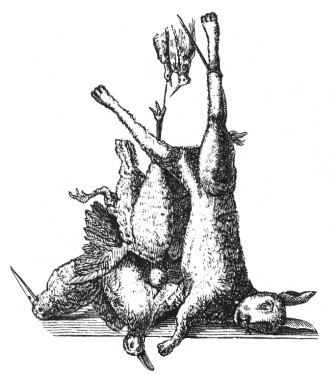
Tinne’s book also abounds in British standards like kedgeree, kippers, roast lamb and pork, Cumberland sauce and summer pudding. Then again her contributors did not send recipes for roast beef, potted meat or savory puddings; evidence of absence pace Mac Con Iomaire, or merely too small a sample to provide a representative glimpse of Ascendancy foodways?
Without a visit to archives in Ireland it is hard to say, but a limited sample is the likelier answer and Mrs. FitzGibbon, to note but one example, includes all such recipes in Irish Traditional Food.
4. Historical investigations.
Since Gaelic times, Irish overlords and their underlings had been famed for lavish hospitality, a tradition that Ascendancy Ireland would uphold until its own demise. In 1600, Sir Christopher Moryson treated three distinguished English officers travelling through Ulster (one would found the Bodleian at Oxford; another would become the first Baron Charlemont) to a Christmas feast along with the local gentry and various hangers-on.
Moryson had captured his estate from its Catholic owner only two years earlier, but this precursor to the fateful Plantation was already entrenched and had firmly stamped his metaphorical escutcheon on the ancient castle. The holiday table was so lavishly laid that the visitors believed it was “such as the Lord Mayor and Aldermen of London must always have at their feasts.” (Somerville-Large 59, 60)
The comparison to upperclass English foodways is unsurprising given their host’s recent arrival in Ireland; it also appears to have been apt. Moryson served
“a large and beautiful collar of brawn with its accompaniments, to wit mustard and muscadel wine; there were well-stuffed geese,… there were pies of venison and of various kinds of game; pasties also, some of marrow with innumerable plums, others of it with coagulated milk,… others which they call tarts, of divers shapes, material and colours made of beef, mutton and veal” in addition to some ‘French’ dishes ‘they designate quelque choses’ that the visitors found ‘vulgar.’” (Somerville-Large 60)
Alison Rosse struggles to find much that is distinctively Irish in the kitchen manuscripts kept by the chatelaines who preceded her at Birr Castle in County Offaly. Her story starts in 1666, when Dorothy Parsons, then mistress of Birr, compiled her ‘household book.’ It included recipes written down by her husband’s aunt Elizabeth, and Parsons explains that she marked “those that are most especially excellent with a “‘EP,’” noting they had been “all approved & tried by ye Lady Elizabeth Parsons in her life time.” (Wilson 127)
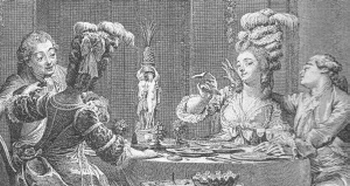
According to Rosse, “[m]ost of the EP recipes seem to be in the mainstream of English sixteenth-century cooking,” a dramatic example of how written records tend to trail actual practice, in this case by as much as a century. (Wilson 127) With that considerable caveat, it is noteworthy that the first evidence of what Rosse considers a traditional Irish dish does not surface until the end of the eighteenth century. One example is a recipe for “Potatoe Loaves;” others include pickled salmon and barm brack, all from a second manuscript, this one compiled by Alice Parsons, the wife of Dorothy’s “great-great-grandson.” (Wilson 127-28)
Consistent with the fashion of their time, the eighteenth century recipes in general appear simpler than the ones Dorothy Parsons recorded. That may not have been the case, however, in fashionable Dublin. Rosse quotes the great Maria Edgeworth (but unfortunately does not disclose the source) describing an evening in the city: “The dinner had two great faults--profusion and pretension. There was, in fact, ten times more on the table than was necessary… there was a disparity between the entertainment and the attendants,” who spilled the sauce, delayed the second course for “a torturing half-hour” and never did manage to get the dishes “placed together rightly on the table.” (Wilson 132)
It is difficult to tell from this what those irritated grandees were eating; as Rosse notes, travellers in Ireland tended to remark on the prodigious amount rather than the nature or quality of the foods they were served. In 1737, an annoyed Lord Orrery described a riotous dinner at Cork:
“I have been at a Feast. Paper mills, Thunder and a King’s Kitchen are soft Music to the Noises I have heard. Nonsense and Wine have flowed in plenty, gigantic Saddles of Mutton and Brobdinghagian [sic] Rumps of Beef weighted down the Table. Bumpers of Claret and Bowls of White Wine were perpetually under my Nose till at last, unable to bear the Torture, I took advantage of a Health at which we all oblig’d to rise, and slipped away, leaving a Hat and Sword to be my representatives.” (Somerville-Large 130)
Although it is interesting to note that apparently papermills always have been noisy as well as noisome, the dinner at Cork sounds like a pretty good time notwithstanding the fastidious Orrery.
Fifty years later Jonah Barrington described Irish hospitality in much the same way. The food remains relatively simple in technique and absolutely lavish in scale.
“The luscious sirloin… frizzed upon its pewter dish. Veal, mutton, turkey, ham, duck and partridge all ‘piping hot’ were ready and willing to leap from their pots and spits into their respective dishes, and to take a warm bath each in its proper gravy. The corkscrew was busily employed… and the punch… perfumed the whole room.” (Somerville-Large 129)
On another occasion, Barrington attended a hunt party on St. Stephen’s Day, “and never did any feast commence with more auspicious appearances of hilarity and dissipation, appearances which were not doomed to be falsified.” (Barrington 42) Nothing in fiction sounds more raucous.
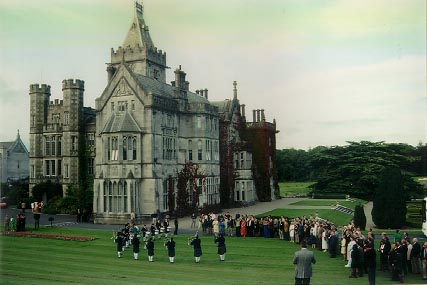
The host got things started before dinner with rounds of ‘cherry-bounce,’ a strong punch. The entertainment included a fiddler, pipers and ‘the old huntsman,’ who liked to sound his horn above the din. These blasts were met with the shouts and songs of revelers “in twelve different keys” and the baying of “[t]wo couple of favourite hounds [that] had been introduced to share in the joyous pastime of their friends and master.” (Barrington 43-44)
The festivities, now fueled by bumpers of claret, lasted all night and past the morning, but not Barrington (“My reason gradually began to lighten me of its burden”). Before passing out, however, he feasted on the several foods served up amidst much cursing by a sole cook, the old huntsman’s “ancient spouse, once a kitchen maid.” (Barrington 42)
Barrington was impressed to the point of rapture; “plump white chickens floated in crowds upon the surface of the water; the simmering potatoes, just bursting their drab surtouts, exposed the delicate whiteness of their mealy bosoms” and “the luscious smoked bacon, bedded on its cabbage mattress, and partly obscured by its own savoury steam, might have tempted the most fastidious of epicures.” (Barrington 42-43) There were quintessentially English devils too, of spiced and spatchcocked chicken, and broiled marrowbones. (Barrington 44)
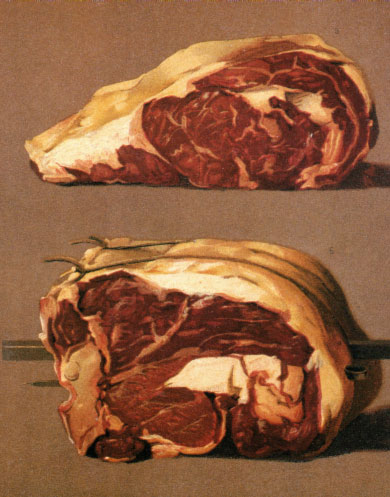
A whole cow hung over a griddle heated by turf; diners could wield a “long knife” to cut their own “fat collops… sliced indiscriminately from her tenderest points… half drowned in their own luscious juices, and garnished with little pyramids of congenial shalots.” (Barrington 42, 43)
If it does not sound like any Texas pitmaster could match the ancient spouse in thrilling her diners, it does sound like elements of the food--potatoes, the bacon and cabbage--bear a distinctly Irish accent.
Unlike the censorious Orrery, but like him demonstrating the grip of Swift on the age, Barrington admired the Irish revelers, favorably contrasting “those joyous and vigorous sportsmen” with their “effeminate” Regency grandsons. The “modern affectation” of these English dandies reduced them to
“mincing their fish and tit-bits at their favourite box in Bond-Street; amalgamating their ounce of salad on a silver saucer; employing six sauces to coax one appetite… lisping out for the scented waiter, and paying him the price of a feast for the modicum of a Lilliputian.” (Barrington 45-46)
Others were discomfited by the gluttony they encountered. Lady Theodosia Bligh wrote in 1741 that one hostess repeatedly cried “‘Lady Bligh has no stomach’ and then my plate was heaped up” with “six great slices of mutton… besides roots and ten quarts of water, I stuffed to humour them.” After dinner the entreating woman “begg’d us we would let her loose our stays, which was really no more than necessary after all the crammings,” even if the practice would have proven scandalous to English sensibilities. (Somerville-Large 131-32)
Consumption on this scale was a constant in Ascendancy circles. Constantia Maxwell writes of eighteenth century Dublin that “[i]ndulgence in claret and port was not the only symptom of that extravagance which brought the descendants of so many Irish gentry of the period into the Encumbered Estates Court, for their meals were so prodigious that one marvels at their digestive capacity.” (Maxwell 102)
For their part Mac Con Iomaire and Kellaghan assert, although again without citation, that during the long eighteenth century, “the Irish gentry generally seemed disinterested in the appearance of their homes and the poor impression this might make upon visitors, [but] this apparent defect as hosts was counterbalanced by lavish displays of hospitality.” (“Royal Pomp” 11)
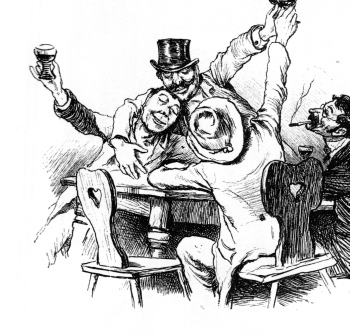
The celebrated diarist Mrs. Delany, English wife of an Irish gentleman, recorded serving a dinner for twelve in 1764. It included “Turbot and Soles, remove Ham; Force meat etc; two partridges and two grouse; rabbits and onions; Pies, sweetbreads and crumbs; Salmigundi; Soup; Boiled chicken; Collop veal and olives; pease; Cream pudding; Plumb Crocant; Chine of Mutton; Turkey in jelly; Hare; Lobster Fricassee” and nine different desserts. (Maxwell 102)
Out in the country this time, Edgeworth describes a dinner served in the “dilapidated mansion” of Ballynahinch in Connemara. She marveled at “such a dinner!” It included venison and other game, salmon and shellfish, “all well cooked and well served… champagne and all manner of French wines.” And yet the great house had only a single teapot; breakfast was eaten in shifts. (Somerville-Large 254, 255)
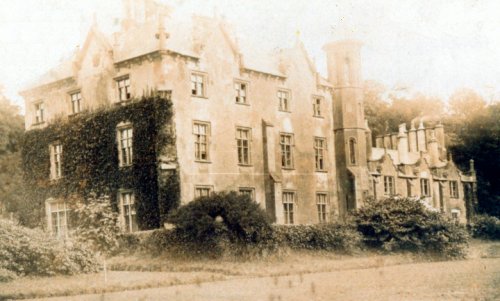
Not in the best of repair
A 1781 letter published in the press states that the Dowager Duchess of Aldborough “consumes every twenty-four hours ten quarts of jelly, four of Madeira, three of port, six pies, four sweetbreads, three pigeons, nine sweet cakes etc.” The Dowager Duchess must have been a tub but the letter was hardly finding fault; it describes her as “that dear, dear creature, the Dowager,” and reports with relief that she “has got over the winter.” (Somerville-Large 131)
Martyn Powell follows the lead of those Irish travellers in The Politics of Consumption in Eighteenth Century Ireland. Food appears throughout his study, but only in the context of display, usually also to great excess and not least at Dublin Castle. Gentry and aristocrats alike expected the viceroy to fete them with sumptuous feasts, and sometimes to treat the middling sort and “lower orders” too. This extension of largesse could approach the unlimited, extending to “Castle underlings, soldiers and the Dublin populace.” (Powell 155)
To curry public favor in 1733, for example, the Lord Lieutenant celebrated the king’s birthday by ordering
“five sirloins of Beef roasted, weighing 48 pounds each, 8 Turkey Cocks, and 30 Sixpenny Loaves to be given to the Soldiers of the Guard, which was served up to them on long Tables in the Castle-Yard, with two Barrells of Ale, and a Hogshead of Wine, and Wax Tapers burning to light them at their Repast. Several Hogsheads of Wine plaid from a Fountain, made for that purpose, among the Populace, who catched it, and drank to their Majesty’s and the Royal Family’s Healths, with loud huzzas and Acclimations of Joy.” (Powell 155)
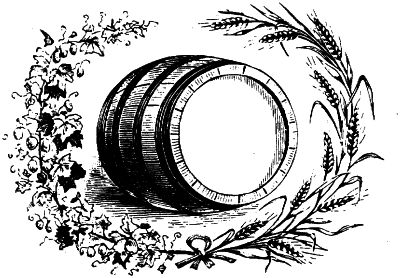
This, however sketchy in terms of preparation and presentation, is the only description of food we get from Powell. And although Barrington says nothing about the foodways of the Quality, at least in Dublin, it does not sound from him like their country counterparts fared any different.
Theodora FitzGibbon obtained access to a number of eighteenth century kitchen manuscripts during the course of her research for Irish Traditional Food. Unfortunately for our immediate purpose, however, she includes no footnotes, bibliography or means of locating them. The passages she quotes and the recipes she describes from these sources therefore are tantalizing rather than definitive. It is possible to observe in general, however, that much of this food also bears a strong and frequently retrograde English stamp.
A kitchen manuscript handwritten by Cathleen Seely in 1717 includes a “musharoom frigassy” flavored with marjoram, thyme and orange juice. If it sounds like an advanced (no sugar or other sweetening) seventeenth century more than an eighteenth century preparation, it is remarkably sophisticated; shallot as well as onion, and claret as well as mutton stock, join the seasonings to create something special. This is, as Mrs. FitzGibbon says, “a delicious dish.” (FitzGibbon 39)
‘Musharoom’ may have been a typically idiosyncratic Irish spelling; it appears in other kitchen manuscripts of the eighteenth century too. Sarah Powers uses the form in a recipe for pickling lobster from 1746. The pickle uses bay, capers, cloves, cucumber, peppercorns, rosemary and white wine along with the musharooms. It would not taste incongruous in the American south today, where pickled shrimp is a traditional treat.
Another southern specialty, the oyster loaf, or peacemaker to New Orleanians, in fact originated at the outset of the eighteenth century in London; Cicely D’Arcy’s eighteenth century Irish kitchen book also includes a recipe. (FitzGibbon 37)
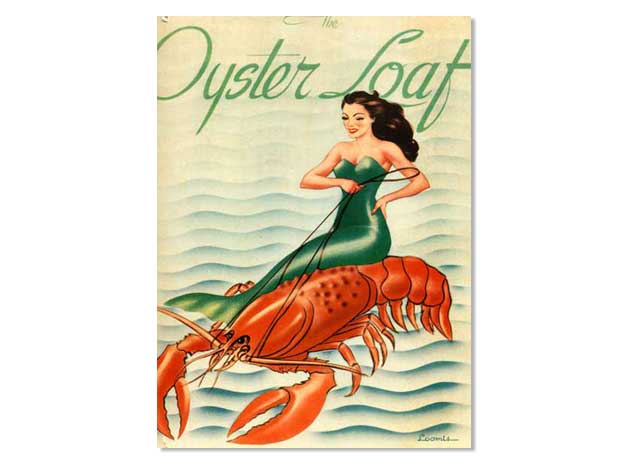
Most of FizGibbon’s sources, however, are English; Charlotte Mason (but an edition was published in Dublin during 1778), Charles Carter, Alexis Soyer, Dorothy Hartley and others. As we have noted elsewhere, and like the oyster loaf, much of what appears in Irish Traditional Food simply records food cooked in Ireland rather than food of Irish origin.
By the end of the eighteenth century a contemporary observed that the Irish gentry “still retain the ancient mode of eating their food… that is, great joints of meat, ribs and sirloins, shoulders and legs which, while retaining their ancient forms, instantly remind us of the animal to which they belonged.” (Somerville-Large 129-30)
5. After the Union, or fall.
Recipes from the manuscript kept at a gentry kitchen in County Waterford during the 1820s still appear simple and English, things like chancellor’s pudding, coriander cake, lemon cake, lime water, all kinds of roasted meat. Some appear positively seventeenth century, like a Yorkshire pudding for the roasts that is spiced with ginger and nutmeg. (Somerville-Large 246)
The gentry of course form a separate species from aristocrats, ‘the elite of the elite’ in the words of J. P. Donleavy, but at least some of the food at Birr may have become simpler by the 1830s as well.
At that time Humphrey O’Sullivan described eating asparagus with hardboiled eggs in butter, “bacon with beef kidneys and white cabbage” and “roast duck with green peas.” (Wilson 129) If, as Rosse infers, guests found the same kind of food at Birr, then the Protestant aristocracy may have been eating much the same fare as the Catholic middling sort, for O’Sullivan enjoyed the foods he described in the company of a priest.
James Boyle, his contemporary, found similar if slightly more rustic fare among the lesser gentry during the course of his work compiling the Irish Ordinance Survey. Both Regina Sexton and Spencer quote him:
“The food of the farmers is plain, wholesome and substantial, consisting of fried bacon or hung beef, boiled beef (chiefly in broth). Excellent broth made of beef, groats and oatmeal, leeks and cabbage is a favourite and comfortable dish.” (Spencer 177)
Rosse speculates, the Editor believes unwisely, that the kind of dishes O’Sullivan described “had been enjoyed in Ireland since the Middle Ages, with no recourse to cookery books.” (Wilson 129) In fact they resemble the kind of sturdy English preparations that Parson Weems embedded in his diary at the midpoint of the eighteenth century.
Rosse’s reference to medieval food is all the more curious because she is of conflicted mind. Rosse ascribes profound culinary significance to the Act of Union in 1801, when the Irish Parliament dissolved and its members decamped to Westminster. The contemporary Parsons, by now Earl of Rosse, had represented the environs of his seat at Birr in the Dublin Parliament. He was an Ascendancy patriot and gave “a remarkably fine speech” against Union during the first series of debates in 1799. (Bunbury) Yet even Rosse would eventually find himself Anglicized.
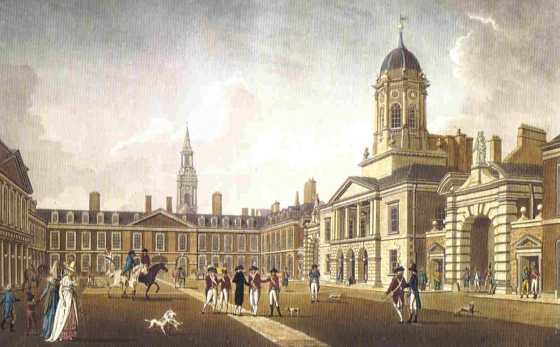
By the 1820s the earl owned a house in London for the parliamentary and social season. Rosse contends from this and in broader terms that the Union “turned the Parsons and other such families back again towards England,” and “so Birr began to fall into the pattern of most aristocratic mid-nineteenth-century British houses.” (Wilson 132, 133)
The Earl and his wife spent more time away from their Irish estate, and by the 1830s their sons had started “a new family tradition of marrying girls from England.” (Wilson 132)
Rosse adds that by then the chatelaine of Birr Castle
“would have had a housekeeper, possibly English--whose ways would be more familiar to her than those of the local Irish whom she knew less well--to run the household efficiently for her, whether she and her family were in Ireland or not.” (Wilson 133)
Thackeray visited Ireland and recorded what he saw in The Irish Sketch Book of 1843. Travellers to Ireland during the eighteenth and nineteenth century consistently remarked on the abundance and size of lobsters; Dublin lawyer, cooked in butter, cream and Irish whiskey, is a simple classic.
Thackeray himself found a company of “sporting young fellows” who prepared a traditional devil adapted to lobster and enhanced by Sherry; no cook or servant appears in his description. They sauced their lobster in a chafing dish (“a machine called a dispatcher”) with ‘catsup,’ most likely mushroom ketchup, cayenne, mustard and vinegar. (Thackeray 22, 23)
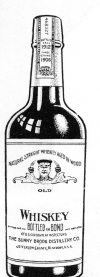
It is fair to infer that these people possessed means; Thackeray describes them as gentlemen, they spent a good part of the evening drinking claret followed by whiskey while throwing sixpence coins to beggars assembled beneath their windows, and some of their whiskey provided extravagant fuel for the dispatcher. Once the dish hit the boil (“it emits a remarkable rich and agreeable odour throughout the apartment”), it got the dose of Sherry and went to table where it was devoured with porter and followed by “whisky-punch.” The Editor wishes she had been there even though Thackeray confides that “[y]ou are recommended not to hurry yourself in getting up the next morning, and may take soda water with advantage--Probatum est.” (Thackeray 23)
Fionnuala O’Reilly, an author and the convenor of silver and furnishings at the Kildare Street University Club in Dublin, inherited a cache of cookbooks tilted toward England from her mother. Like Rosse, she ascribes a profound (and in her case deleterious) impact to the Act of Union on Irish cooking. Her books include S. W. Stavely’s New Domestic Cookery, an 1828 edition originally published in the eighteenth century; Mrs. Rundell’s New System of Domestic Cookery (1806); Dainty Dishes for Indian Tables from Calcutta (anon. 1881), for pickles and chutneys (“more robust!” according to O’Reilly); and her grandmother’s favorite, Miss Parloa’s New Cook Book (1882). All of these books “show the effects of long ages of use.” (O’Reilly)
6. A detour to Boston.
The outlier of course is Maria Parloa, an instructor at the ‘Young Ladies’ Cooking School’ in Boston for many years starting in 1879. It is unclear how the New Cook Book found its way to the O’Reilly household in Ireland, but Parloa did work with an Irish woman, Joanna Sweeney, for several years at the Boston Cooking School and that may account in some way for the connection, but this is speculation requiring further research. (Stavely 102-03)

Boston
Meanwhile, Parloa herself was Bostonian and her recipes reflect the Anglophile bent of the city at her time. She also, however, was swept up in the concurrent Colonial Revival so the New Cook Book bears a Yankee stamp too, in recipes like chowder and Indian pudding which, for the uninitiated, takes cornmeal, milk, molasses and nothing more to produce one of the great desserts of the western world.
It would be interesting to determine whether much of this New England fare ever emerged from Irish kitchens along with all of those English dishes. At least some of it did, at least in the O’Reilly kitchen; Mrs. Parloa’s angel food cake, a recipe originating in the American south not long before the publication of her cookbook, would become a family tradition for Christmas. (O’Reilly)
7. Back to the archipelago.
The records that Rosse cites support the notion that Ascendancy foodways had become (or remained) Anglicized. The menu from a grand dinner at Birr for the British Association for the Advancement of Science in 1857 “had,” according to Rosse, “little of a distinctive character” and the items on the menu are indistinguishable from what would have been served to the same guests across the Irish Sea.
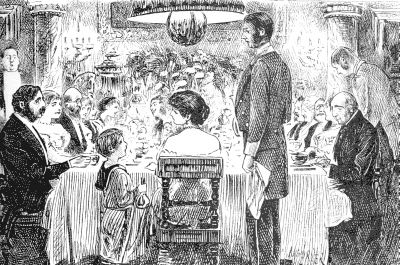
Some grace notes from our sources do appear characteristically Irish; the practice of serving roast birds with bacon, ham or especially sausage is particularly appealing. Another distinctive practice involves turf or peat, the traditional fuel of Ireland. Grilling smaller game birds like partridge, snipe or woodcock over turf gives them an unmistakable tang. The savory ciste is a simpler version of suet pudding; instead of lining a basin with pastry, it only forms a deck over the filling. The most traditional ciste, or coffin, probably contains pork chops and kidney; the bones pop as masts through a crust that incorporates raisins or currants in some recipes.
8. Into Irish independence and on to Ascendancy oblivion.
The Editor’s sources on the subject of Ascendancy foodways, never vast, get even scarcer for the twentieth century. The limited evidence, however, presents a fairly common thread.
According to Rosse, her predecessor’s “menus for dinners and lunches were in the mainstream of fashionable 1930s cooking” and there can be no doubt she means fashionable English cooking; her mother-in-law had annotated copies of Lady Sysonby’s Cook Book (1935), Food for the Greedy from 1936, and Good Sweets, written in 1937 by Ambrose Heath. (Wilson 136, 151)
And yet it must have been different too, if only in degree or by intangibles. Rosse believes that the kitchens of Birr Castle baked soda bread ‘almost every day,’ and the potato did find its way into all manner of breads and cakes to an extent never approached in England.
Novelists, both Irish and English, repeatedly have depicted the madcap habits and chaotic meals of Ascendancy establishments fallen to disrepair but still trying to entertain on the grand scale.
In Troubles, to cite but one example, J. G. Farrell sketches a guest during the 1920s who stumbles in horror upon a sheep’s head forgotten for weeks, to decompose in a bedside drawer beneath a leaking roof. The cook-housekeeper at Birr itself a decade later recalled “the time the lobsters, brought back alive in the boot of the car from Dublin, ate the sole intended for the next meal…. ” (Wilson 135)
By 1946, when J. P. Donleavy landed in Ireland, what food he describes through the haze of his debauchery sounds familiar. He
“first encountered sherry prior to Sunday lunch. And the sacred ritual of such things as roast beef and Yorkshire pudding with black uniformed maids scurrying back and forth to keep the chill from superlative gravies, roast potatoes and Brussels sprouts. And following the spongy sweet delight of trifle, to withdraw upstairs to the drawing room…. ” (Ireland 27)
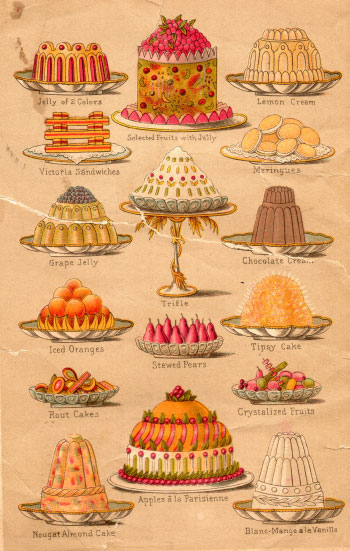
All of this transpired at the townhouse of a family called O’Callaghan, “a Georgian mansion off Fitzwilliam Square” following a visit to their country seat, where he found a “flowing abundance of food and drink.” So Donleavy was dealing with Irish gentry, whether Catholic or Protestant, and the Sunday lunch he described could as easily have been devoured in Dartmouth or Deal as in Dublin. (Ireland 26, 27)
9. Some assembly required.
All of this is anecdotal so none of it tells us much in strictest historical terms. The Editor has not, at least not yet, had recourse either to the cited manuscripts or to a number of others kept in Ireland. Neither, it seems, has anyone else who has addressed matters Ascendancy in writing, with the exception of Alison Rosse. Her aim back in 1993 was, however, more the sharing of recipes, less the tracing of their historical significance.
Sources exist: Maeve O’Riordan of University College Cork kindly has directed the Editor to a number of archives. Among them are the Grehen Estate Collection at UCC and various family papers held by the National Library of Ireland. The records include menu cards, house accounts and the like from Ascendancy sources, notably the Castletown, Doneraile and Inchiquin collections.
Readers therefore are invited to enter the void and produce a comprehensive but readable history of Ascendancy foodways, inclusion of customs and recipes preferred. Citations would be essential; with apologies to the graphic creativity of National Lampoon, we must now more than ever Protest against the RISING TIDE of Mediocrity, at least in the field of foodways history.
Notes:
The Editor wishes to thank Fionnuola O’Reilly and Maeve O’Riordan for sharing their considerable insights about Irish foodways.
Except as otherwise noted, the dates of publication for books in the possession of Ms. O’Reilly refer to the first editions and not necessarily to her own copies. Mrs. Rundell for example remained in print throughout the nineteenth century and ran to over seventy-three editions published in several cities.
Sources:
Sir Jonah Barrington, The Ireland of Sir Jonah Barrington (Hugh Staples, (ed.), (Seattle 1967)
Katherine Cahill, Mrs. Delaney’s Menus, Medicines and Manners (Dublin 2005)
Alexander Cockburn, “Gastro-Porn,” The New York Review of Books (8 December 1977)
J. P. Donleavy’s Ireland: In All Her Sins and in Some of Her Graces (New York 1986)
Auguste Escoffier, The Escoffier Cookbook: A Guide to the Fine Art of French Cuisine (New York 1989)
Theodora FitzGibbon, Irish Traditional Food (London 1983)
Molly Keane, Nursery Cooking (London 1985)
Mairtin Mac Con Iomaire & Dorothy Cashman, “Irish Culinary Manuscripts and Printed Cookbooks: A Discussion,” Dublin Institute of Technology School of Culinary Arts and Food Technology (Year 2011, 80-101)
Mairtin Mac Con Iomaire & Tara Kellaghan, “Royal Pomp: Viceregal Celebrations and Hospitality in Georgian Dublin,” Dublin Institute of Technology School of Culinary Arts and Food Technology (1 July 2011)
Mairtin Mac Con Iomaire, “Searching for Chefs, Waiters & Restauranteurs in Edwardian Dublin,” Petits Propo Culinaire No. 86 (September 2008) 92-126
Constantia Maxwell, Dublin Under the Georges London 1956)
Fionnuala O’Reilly, correspondence to the Editor (6 and 12 February 2012)
Martyn Powell, The Politics of Consumption in Eighteenth-Century Ireland (Basingstoke, Hampshire 2005)
Alison Rosse, “Ireland: Birr Castle,” in C. Anne Wilson (ed.), Traditional Country House Cooking (London 1993)
Peter Somerville-Large, The Irish Country House: A Social History (London 1995)
Colin Spencer, British Food: An Extraordinary Thousand Years of History (London 2002)
Fortune Stanley, English Country House Cooking: A family cookery book (London 1972)
Keith Stavely & Kathleen Fitzgerald, Northern Hospitality: Cooking by the Book in New England (Amherst 2011)
William Makepeace Thackeray, The Irish Sketchbook (orig. publ. London 1842; Gloucester, England 1990)
www.turtlebunbury.com/history/history_irish/history_hellfire.html

